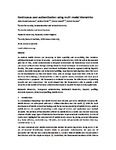Continuous user authentication using multi-modal biometrics
| dc.contributor.author | Saevanee, H | |
| dc.contributor.author | Clarke, Nathan | |
| dc.contributor.author | Furnell, Steven | |
| dc.contributor.author | Biscione, V | |
| dc.date.accessioned | 2017-11-29T23:48:48Z | |
| dc.date.available | 2017-11-29T23:48:48Z | |
| dc.date.issued | 2015-09 | |
| dc.identifier.issn | 0167-4048 | |
| dc.identifier.issn | 1872-6208 | |
| dc.identifier.uri | http://hdl.handle.net/10026.1/10346 | |
| dc.description.abstract |
As modern mobile devices increase in their capability and accessibility, they introduce additional demands in terms of security - particularly authentication. With the widely documented poor use of PINs, Active Authentication is designed to overcome the fundamental issue of usable and secure authentication through utilizing biometric-based techniques to continuously verify user identity. This paper proposes a novel text-based multimodal biometric approach utilizing linguistic analysis, keystroke dynamics and behavioural profiling. Experimental investigations show that users can be discriminated via their text-based entry, with an average Equal Error Rate (EER) of 3.3%. Based on these findings, a framework that is able to provide robust, continuous and transparent authentication is proposed. The framework is evaluated to examine the effectiveness of providing security and user convenience. The result showed that the framework is able to provide a 91% reduction in the number of intrusive authentication requests required for high security applications. | |
| dc.format.extent | 234-246 | |
| dc.language | en | |
| dc.language.iso | en | |
| dc.publisher | Elsevier BV | |
| dc.subject | Biometrics | |
| dc.subject | Transparent authentication | |
| dc.subject | Multimodal biometrics | |
| dc.subject | Linguistic profiling | |
| dc.subject | Keystroke dynamics | |
| dc.subject | Behavioural profiling | |
| dc.subject | Mobile device | |
| dc.title | Continuous user authentication using multi-modal biometrics | |
| dc.type | journal-article | |
| dc.type | Journal Article | |
| plymouth.author-url | https://www.webofscience.com/api/gateway?GWVersion=2&SrcApp=PARTNER_APP&SrcAuth=LinksAMR&KeyUT=WOS:000367124600015&DestLinkType=FullRecord&DestApp=ALL_WOS&UsrCustomerID=11bb513d99f797142bcfeffcc58ea008 | |
| plymouth.volume | 53 | |
| plymouth.publication-status | Published | |
| plymouth.journal | Computers & Security | |
| dc.identifier.doi | 10.1016/j.cose.2015.06.001 | |
| plymouth.organisational-group | /Plymouth | |
| plymouth.organisational-group | /Plymouth/Faculty of Science and Engineering | |
| plymouth.organisational-group | /Plymouth/Faculty of Science and Engineering/School of Engineering, Computing and Mathematics | |
| plymouth.organisational-group | /Plymouth/REF 2021 Researchers by UoA | |
| plymouth.organisational-group | /Plymouth/REF 2021 Researchers by UoA/UoA11 Computer Science and Informatics | |
| plymouth.organisational-group | /Plymouth/Users by role | |
| plymouth.organisational-group | /Plymouth/Users by role/Academics | |
| dc.identifier.eissn | 1872-6208 | |
| dc.rights.embargoperiod | Not known | |
| rioxxterms.versionofrecord | 10.1016/j.cose.2015.06.001 | |
| rioxxterms.licenseref.uri | http://www.rioxx.net/licenses/all-rights-reserved | |
| rioxxterms.type | Journal Article/Review |


